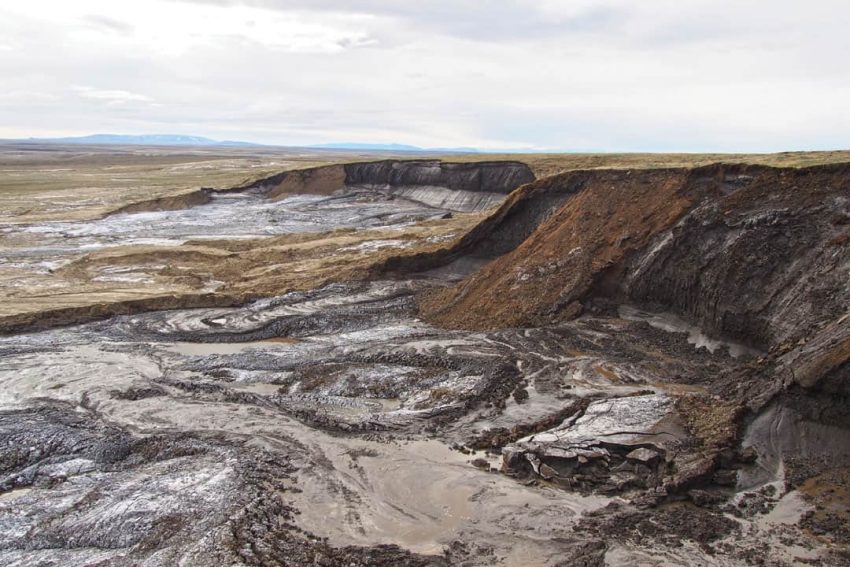Is the permafrost melting?
Currently, permafrost covers some huge areas (in the Northern Hemisphere, it is estimated to be 9 million square miles, the size of the U.S., Canada, and China combined), but it is shrinking.6
Because the Arctic is warming about twice as fast as more temperate areas and permafrost is sensitive to even small changes in temperature, permafrost is melting faster than expected, surprising scientists. A widely cited study in the journal Nature Climate Change estimates that if the Earth warms to 2°C above pre-industrial levels (the course we are on now), permafrost will decrease by 40%.7
Permafrost and the climate crisis
Melting permafrost has many consequences. First, melting releases greenhouse gases, especially methane, into the atmosphere. This creates a feedback loop – as more permafrost melts, more greenhouse gases are released into the atmosphere, and the climate warms further.8 Second, melting permafrost has local impacts, such as destabilizing buildings and transportation systems, and potentially devastating floods or landslides/mudslides.
In addition to the ecological and economic impacts, communities living on permafrost have begun to lose buildings, and in some places entire cities may have to be relocated. In Alaska, Greenland, Canada, and Russia, melting permafrost has led to the collapse or subsidence of homes and buildings. In Vorkuta, Russia, the structural integrity of 40% of the buildings has been compromised, and in Norilsk, a city of 175,000 people, 60% of the buildings have been damaged by the thawing of the permafrost and 10% of the city’s houses have already been abandoned.
It is also difficult to rebuild due to the shifting ground.9 In many of these places, housing is already scarce, and the majority of those affected are indigenous people whose communities have lived in these areas for thousands of years.
Ecological Impacts
Melting permafrost changes landscapes. As permafrost thaws, as is happening in the Canadian Arctic, Alaska, Russia and elsewhere, rich landscapes that once provided food for grizzly bears, caribou and other animals are disappearing under the accumulation of soil. This is because the soil is pushed up and rearranged when the water beneath the surface contracts as the ice in it melts. Food plants for animals, such as cranberries, blueberries, shrubs, lichens and other edible plants, do not survive the muddy, silty onslaught.
Release of greenhouse gases
The melting of permafrost, as a result of human-caused climate change, can create a dangerous feedback loop. According to a study published in the journal Nature, there is an estimated 1,400 gigatons of carbon in the permafrost in the Arctic alone, and that carbon is being released faster than expected.8 That’s about four times what humans have emitted since the beginning of the industrial revolution and makes it one of the largest carbon sinks in the world. If this carbon is released, it should be factored into the global output that scientists use to better understand the future impacts of climate change.
If more greenhouse gases are released from the permafrost as it melts, temperatures will warm faster, releasing more gases, further melting the permafrost, and so on.
Viruses and Bacteria.
Certain organisms can be preserved in ice for thousands of years. The conditions are almost ideal – a cold, dark and oxygen-deficient environment means that some of these microscopic cells can survive. Viruses, fungi and bacteria frozen in the permafrost can become active when flushed into the water supply via meltwater.
This happened back in 2016, when an anthrax-carrying reindeer that had been buried in the permafrost for 75 years thawed. The anthrax entered the water supply and dozens became ill, a young boy died, and thousands of reindeer also perished, according to a study published in the journal Plos One.10 The Spanish flu virus of 1918 was also found on intact corpses found in Alaska, and even some 40,000-year-old worms came back to life after thawing. The full extent of the contamination that can occur from ancient viruses and bacteria lurking in permafrost is unknown.
Economic Impacts
For indigenous peoples, such as the Inuit, who live in areas of melting permafrost, finding food will become increasingly difficult because of the thousands of landslides and thermokarsts that have already occurred and will continue to occur in the coming years. Those changes in landform can alter coastlines through collapse, can change how and where streams flow, and can cause lakes to empty. All of these phenomena can also have negative impacts on the wildlife in the area, on which people depend.
Melting permafrost also leads to the collapse of buildings and roads, which must be rebuilt or abandoned, as well as any commercial activity, from oil and gas drilling to oil pipelines and any other business or community that depends on stable ground and a reliable water supply. Because of the broad impact, it is difficult to attribute an exact dollar amount to permafrost melting.
Other impacts
Melting permafrost is likely to uncover the remains of ancient civilizations, animals and earth history that have been buried for thousands of years. A 3,000-year-old tomb of a Siberian prince has already been discovered in a remote area, a boon for archaeologists studying that time and place.

